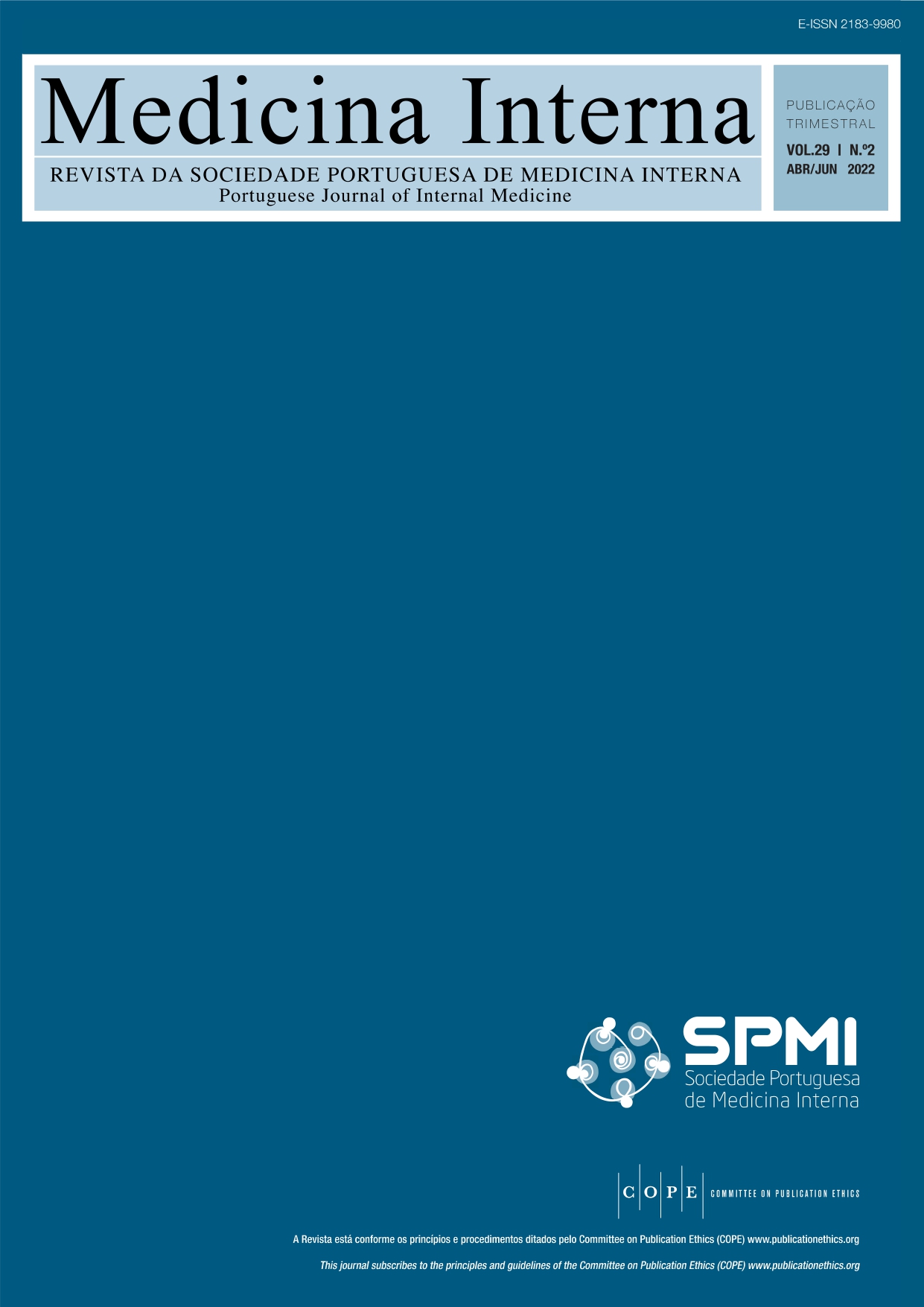Challenges of Referral to the National Network of Continuous Integrated Care: The Experience in a Hospital
DOI:
https://doi.org/10.24950/rspmi.213Keywords:
Delivery of Health Care, Integrated, Hospitalization, Length of StayAbstract
Introduction: In 2006, the National Network for Continuing
Integrated Care was created in Portugal to respond to the
needs of a population with growing comorbidities. The aim of
this study is to assess the length of hospital stay and medical
complications of patients referred to the network in the same
period of four different years.
Material and Methods: Observational, retrospective study
of medical patients with medical conditions referred from the
hospital in the months of April to June 2010, 2012, 2016 and
2019. Demographic, clinical and referral data were obtained
from clinical processes. Statistical analysis was performed with
IBM SPSS Statistics®, p < 0.05 was considered statistically
significant.
Results: 205 patients were included. The main reasons
for admission were infection (37.1%) and acute cerebrovascular event (35.6%) and for referral was functional rehabilitation
(79.5%). There was an increase in length of stay over the years
(p < 0.001) and from referral to hospital discharge, p = 0.04.
After clinical discharge, 42.9% developed medical complications and after hospital discharge, at least 31.3% needed to
be readmitted within 3 months. The number of complications
did not rise.
Discussion: The increase in hospital stays over the years
since the creation of the network implies an overload in hospital
health care, even though there is no increase in clinical complications before and after discharge.
Conclusion: There is a clear need to strengthen the network
and social support to the chronically ill and to create studies to
assess the economic and health impact of hospital referrals.
Downloads
References
Global, regional, and national incidence, prevalence, and years lived with disability for 301 acute and chronic diseases and injuries in 188 countries, 1990-2013: a systematic analysis for the Global Burden of Disease Study 2013. Lancet. 2015;386:743-800. doi: 10.1016/S0140-6736(15)60692-4.
Hajat C, Stein E. The global burden of multiple chronic conditions: A narrative review. Prev Med Rep. 2018;12:284-93. doi: 10.1016/j.
pmedr.2018.10.008
Ferreira M, Neto I, Cabral D. Cuidar no domicílio: Sobrecarga da família/cuidador principal com doente oncológico paliativo [Dissertação]. Porto: ICBAS, Universidade do Porto; 2011.
Gemito ML, Mestre-Escola S, Silva CA, Massapina I. Economia e Sociologia: Modelos e Perspetivas de Relacionamento na Saúde. Évora; 2007;38: 68-84.
Decreto- Lei nº 101/2006. Diário da República. Série I A. Nº 109.
Decreto-Lei nº 172/2012. Diário da República. Série I. Nº 52.
Guia da Rede Nacional de Cuidados Continuados Integrados (RNCCI). Unidade de Missão para os Cuidados Continuados Integrados. Lisboa: RNCCI; 2013.
Ferreira L, Almeida A. O efeito da referenciação de utentes para a Rede Nacional de Cuidados Continuados Integrados sobre a demora média dos internamentos no Centro Hospitalar do Porto [Dissertação]. Porto: FEP, Universidade do Porto; 2012.
Gonçalves AR. Estudo da adequação da Rede Nacional de Cuidados Continuados Integrados às necessidades da população – conhecimento da realidade como instrumento de apoio à gestão [Dissertação]. Bragança: Instituto Politécnico de Bragança;2013.
Relatório de monitorização da Rede Nacional de Cuidados Continuados. Administração Central do Sistema de Saúde, Direção Regional de Saúde 2019. Lisboa: DGS; 2019.
Moura BP. O Impacto da Rede Nacional de Cuidados Continuados Integrados (RNCCI) na Demora Média Hospitalar. Lisboa: Universidade Nova de Lisboa; 2014.
Pires L, Maia J, Ferreira T, Paiva P, Correia JA. Fatores condicionadores de alta em Medicina Interna: O caso dos doentes propostos à RNCCI (Rede Cuidados Continuados) e/ou propostos a lar [Adaptação da comunicação oral apresentada no 23º Congresso de Medicina Interna]. Porto: Centro Hospitalar do Porto; 2017.
Costa A, Dias A, Coimbra SM, Marques S, Dourado A, Gonçalves MG, et al. Estudo das dificuldades sentidas pelos Prestadores da Rede Nacional de Cuidados Continuados Integrados [Dissertação]. Lisboa: Ordem dos Médicos; 2016.
Charlson ME, Pompei P, Ales KL, MacKenzie CR. A new method of classifying prognostic comorbidity in longitudinal studies: development and validation. J Chronic Dis. 1987;40:373-83.
Unidade de Gestão e Acompanhamento da Rede Nacional de Cuidados Continuados Integrados. Guia Prático – Rede Nacional de Cuidados Continuados Integrados. Lisboa: Instituto da Segurança Social, I.P. Instituto da Segurança Social; 2021.
Direção-Geral da Saúde. Programa Nacional para as Doenças Cérebro-cardiovasculares. Portugal - Doenças cérebro cardiovasculares em números. Lisboa: DGS; 2013.
Lakshminarayan K, Berger AK, Fuller CC, Jacobs DR Jr, Anderson DC, Steffen LM, et al. Trends in 10-year survival of patients with stroke hospitalized between 1980 and 2000: the Minnesota stroke survey. Stroke. 2014;45:2575-81. doi: 10.1161/STROKEAHA.114.005512.
Wafa HA, Wolfe CDA, Bhalla A, Wang Y. Long-term trends in death and dependence after ischaemic strokes: A retrospective cohort study using the South London Stroke Register (SLSR). PLoS Med. 2020; 17: e1003048. doi:10.1371/journal.pmed.1003048.
Entidade Reguladora da Saúde. Avaliação do acesso dos utentes aos cuidados continuados de saúde: Relatório de 05 de fevereiro de 2013. Lisboa: ERS; 2013.
Downloads
Published
How to Cite
Issue
Section
License
Copyright (c) 2022 Medicina Interna

This work is licensed under a Creative Commons Attribution 4.0 International License.
Copyright (c) 2023 Medicina Interna






